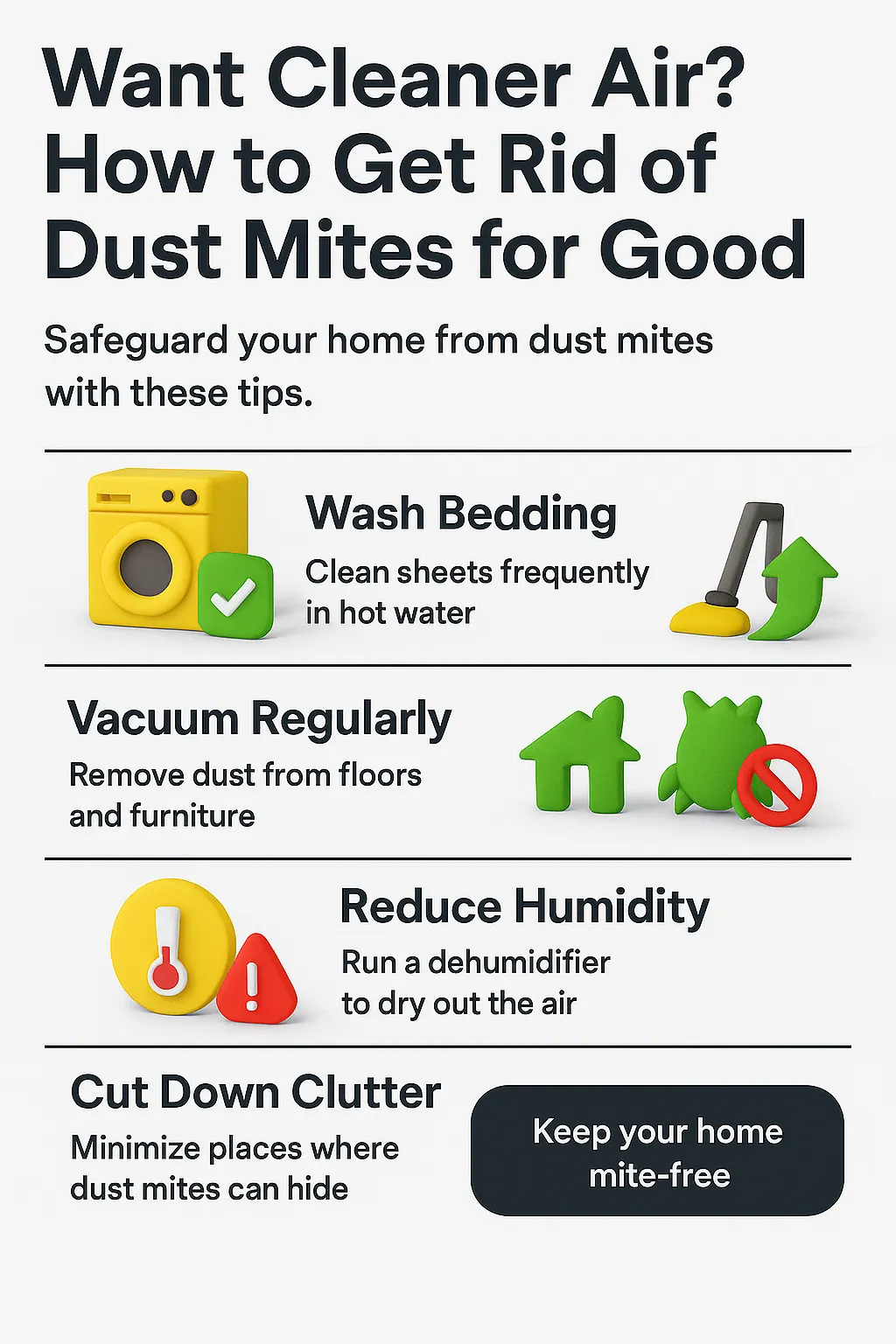Why Your Allergies Might Start at Home
After years of dealing with indoor allergy symptoms, I discovered that dusting and vacuuming weren’t enough. The real problem was dust mites—tiny pests thriving in mattresses, furniture, and air systems. If you’re ready to stop sneezing and start breathing easier, this guide offers a firsthand-tested strategy on how to get rid of dust mites for good and make your home a cleaner, healthier place.
Top Takeaways
- Dust mites are found in most homes, especially in soft surfaces like bedding, carpets, and upholstery.
- High humidity helps them thrive—keeping levels under 50% is key.
- A layered strategy combining washing, filtering, and humidity control works best.
- Relief can begin within days with consistent action.
- Lasting air quality improvement requires routine—not one-time cleaning.
Clean-Air Strategy: Fast & Lasting Relief From Dust Mites
Dust mites may be invisible, but their impact on your breathing and sleep is very real. To get rid of them effectively, target their hiding spots and what helps them multiply.
Focus on the bedroom
- Wash bedding weekly in hot water (130°F or higher)
- Use allergen-proof covers on pillows and mattresses
Don’t overlook soft surfaces
- Vacuum carpets, curtains, and upholstery with a HEPA filter vacuum
Control indoor air
- Run a dehumidifier to maintain humidity below 50%
- Improve airflow in stuffy rooms
Upgrade your filtration
- Install a high-efficiency MERV 13 air filter in your HVAC system
- Use portable HEPA purifiers in bedrooms or shared spaces
Stay consistent
- Small efforts done regularly lead to big improvements in air quality
Quote From Experience
“It wasn’t one product that made the difference—it was the system I put in place. Allergen-proof bedding, hot water washes, dry air, and better filters changed everything.”
Case Study & Real-Life Example: What Actually Works
My personal results
I struggled with allergy symptoms for years—until I started:
Washing bedding in hot water twice a week
Using mattress and pillow encasements
Switching to a MERV 13 HVAC filter
Running a dehumidifier to keep air below 50% humidity
Using an indoor air quality monitor
After 10 days, I was sleeping better, waking up clear-headed, and no longer relying on allergy meds.
One family’s approach
A family of four in a humid climate replaced carpet with hard flooring, used HEPA purifiers, and kept humidity low. Their kids had fewer allergy flare-ups and needed less medication after a few weeks of applying this method.
Why it works
These practices align with guidelines from the Environmental Protection Agency (EPA) and National Institutes of Health (NIH), combining science with consistent home care for long-term relief.
I struggled with allergy symptoms for years—until I started:
Washing bedding in hot water twice a week
Using mattress and pillow encasements
Switching to a MERV 13 HVAC filter
Running a dehumidifier to keep air below 50% humidity
Using an indoor air quality monitor
A family of four in a humid climate replaced carpet with hard flooring, used HEPA purifiers, and kept humidity low. Their kids had fewer allergy flare-ups and needed less medication after a few weeks of applying this method.
These practices align with guidelines from the Environmental Protection Agency (EPA) and National Institutes of Health (NIH), combining science with consistent home care for long-term relief.
Supporting Statistics
80% of homes in the U.S. have dust mites, especially in soft furnishings and bedding
Source – NIH
Just 2 micrograms of allergen per gram of dust can cause asthma symptoms in sensitive people
Source – Lawrence Berkeley National Laboratory
Indoor humidity above 50% increases respiratory issues by 30–70%
Source – IAQ Science
80% of homes in the U.S. have dust mites, especially in soft furnishings and bedding
Source – NIH
Just 2 micrograms of allergen per gram of dust can cause asthma symptoms in sensitive people
Source – Lawrence Berkeley National Laboratory
Indoor humidity above 50% increases respiratory issues by 30–70%
Source – IAQ Science
Final Thoughts: Clear Air Requires a Clear Plan
You can’t spot dust mites—but you can feel the effects. I learned that it takes more than occasional cleaning to get real relief. Once I made a few simple changes and stuck to them, my symptoms started to disappear.
What helped most
Weekly hot washes
Allergen-proof bedding
HEPA filters
Humidity control
Monitoring air quality
My take:
Dust mite control isn’t a task—it’s a habit. Keep at it, and your air will stay clean, your allergies will ease, and your home will feel fresher every day.
Weekly hot washes
Allergen-proof bedding
HEPA filters
Humidity control
Monitoring air quality
Dust mite control isn’t a task—it’s a habit. Keep at it, and your air will stay clean, your allergies will ease, and your home will feel fresher every day.
Next Steps: Take Action Today
Wash sheets and pillowcases weekly in hot water (130°F or higher)
Encase mattresses and pillows in allergen-proof covers
Use a hygrometer to monitor humidity and keep it below 50%
Run a dehumidifier in humid rooms
Vacuum frequently with a HEPA-filtered vacuum
Upgrade your HVAC filter to MERV 11 or MERV 13
Place HEPA air purifiers in high-use rooms
Use an air quality monitor to track progress
Adjust your routine monthly based on results
Pro Tip: Create a dust mite control checklist to stay on track and make it part of your weekly cleaning schedule.
Wash sheets and pillowcases weekly in hot water (130°F or higher)
Encase mattresses and pillows in allergen-proof covers
Use a hygrometer to monitor humidity and keep it below 50%
Run a dehumidifier in humid rooms
Vacuum frequently with a HEPA-filtered vacuum
Upgrade your HVAC filter to MERV 11 or MERV 13
Place HEPA air purifiers in high-use rooms
Use an air quality monitor to track progress
Adjust your routine monthly based on results
